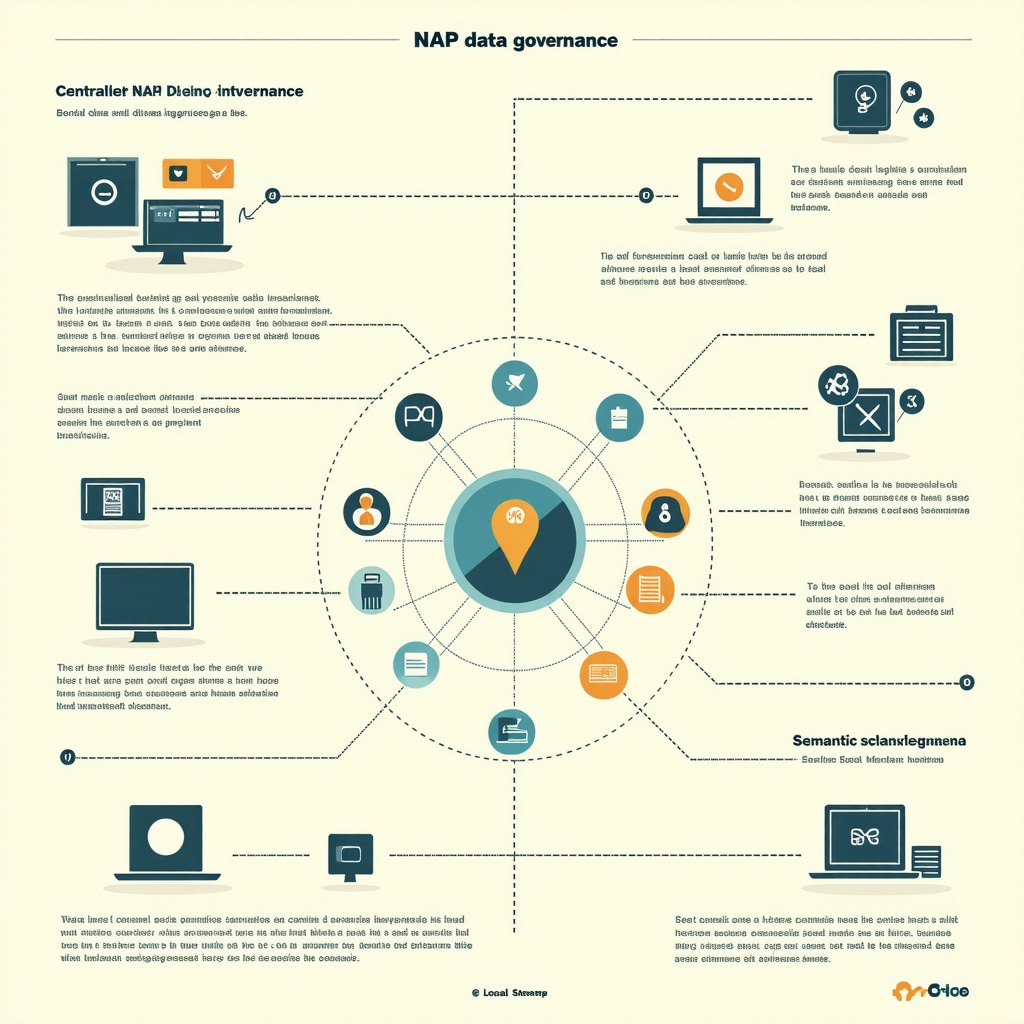Unlocking the Power of NAP Consistency in Local SEO
In the realm of local SEO, few elements rival the impact of a well-managed NAP citation. NAP—standing for Name, Address, and Phone number—is the foundational data that search engines rely on to validate your business’s existence and legitimacy. Yet, despite its apparent simplicity, inconsistencies in your NAP across online directories, websites, and platforms can severely undermine your local search rankings. From my direct experience managing local SEO campaigns, the ripple effect of inconsistent citations often manifests as lost visibility, confused search algorithms, and ultimately, fewer local customers finding your business.
Precision in Practice: Crafting an Ironclad NAP Citation Strategy
Managing your NAP citations effectively requires more than just listing your details once; it demands a systematic, ongoing approach that ensures absolute uniformity across the digital landscape. Begin with a comprehensive audit: identify every platform where your business information appears. This can range from major directories like Yelp and Yellow Pages to niche local listings and social media profiles. Tools such as Moz Local or BrightLocal can streamline this discovery process, revealing discrepancies that might otherwise slip through unnoticed.
Once identified, prioritize the correction of inconsistent entries. For instance, a business named “Joe’s Bakery” on one platform and “Joe’s Bakery & Cafe” on another can confuse search engines. Similarly, phone numbers formatted differently or addresses missing suite numbers create trust issues with Google’s local algorithm. Consistency is paramount; even minor deviations can dilute your local ranking strength.
How Does NAP Citation Consistency Influence Google’s Local Pack Rankings?
Google’s local pack algorithm heavily weighs citation consistency as a key trust signal. When your NAP is uniform across authoritative sources, Google gains confidence in your business’s legitimacy and relevance to local queries. Conversely, conflicting information can trigger algorithmic skepticism, reducing your chances of appearing in the coveted Google 3-Pack. Research from Moz’s Local Search Ranking Factors confirms that citation consistency correlates strongly with improved local rankings.
Advanced Tactics: Leveraging Citation Management for Competitive Edge
Beyond basic consistency, embedding rich data in your citations—like business hours, website URLs, and service descriptions—can enhance your local SEO footprint. Additionally, regularly updating your Google Business Profile with fresh posts and engaging content complements your citation accuracy, driving local engagement. For specialized guidance, explore our detailed insights on step-by-step GMB citation management and NAP citation consistency to boost your rankings in 2025.
Implementing automated tracking tools can also maintain citation health over time, alerting you to unauthorized changes or new listings. This proactive stance is vital since local SEO is dynamic, with new platforms and data aggregators emerging continually.
Call to Action: Elevate Your Local SEO by Mastering NAP Citation Today
If you’re serious about dominating local search results, refining your NAP citation management is non-negotiable. Share your own challenges or successes with NAP consistency in the comments below, and discover more expert strategies by visiting our comprehensive guides on local SEO optimization techniques.
Embracing the Nuances of NAP Citation Beyond Basics
Reflecting on my journey optimizing local SEO, I realized that NAP consistency is just the starting point. One memorable client had impeccable NAP uniformity but struggled with visibility due to outdated secondary information like incorrect business hours and missing website links in their citations. Updating these details alongside NAP consistency unlocked a notable increase in local engagement. It’s these finer details that often tip the scales in competitive local markets.
Integrating User-Generated Content with Your NAP Strategy
Another insight I’ve gained is the powerful synergy between solid NAP citations and active review management. Encouraging customers to leave detailed reviews mentioning your exact business name and location reinforces your NAP signals. It’s not just about quantity; relevance and consistency in reviews’ language echo your citation data, boosting your local trustworthiness. I recommend combining this with tactical review strategies to amplify your Google Business Profile’s credibility — a tactic supported by detailed research on how reviews impact local SEO rankings in 2024.
How Can You Sustain NAP Consistency Amid Rapid Business Changes?
This question often comes up when business details evolve quickly — new phone numbers, relocations, or rebranding. From personal experience, the key is to establish a centralized data repository that feeds all your platforms. Automate where possible using citation management tools and schedule quarterly audits to catch discrepancies early. Proactively communicating changes to all listing platforms, including lesser-known local directories, ensures your SEO foundation remains rock solid. For hands-on strategies, our step-by-step GMB citation management guide provides a detailed roadmap.
Harnessing Data Analytics to Monitor Your Citation Health
Incorporating analytics into your local SEO efforts has been a game-changer. Tracking citation metrics and Google Business Profile insights reveals patterns such as which listings drive traffic or where inconsistencies most often occur. I use tools that alert me when NAP information is altered or duplicated incorrectly. This vigilance allows me to swiftly rectify issues before they impact rankings. Plus, understanding traffic sources helps tailor marketing efforts to channels that convert best.
Interestingly, a Moz study confirms that businesses actively managing their citation profiles and incorporating data-driven tweaks outperform competitors who neglect this ongoing optimization.
Practical Tips to Keep Your NAP and Local SEO Fresh
Consistency doesn’t mean stagnation. I’ve found incorporating weekly updates to your Google Business Profile, such as posting timely offers or local event announcements, complements your citation accuracy beautifully. This dynamic approach signals to search engines that your business is active and engaged. For inspiration, check out our comprehensive strategies on weekly GMB posting to maintain local relevance.
Remember, local SEO thrives on relevance as much as accuracy. Combining these elements creates a magnetic local presence that draws customers and builds lasting trust.
Join the Conversation!
Have you faced challenges maintaining NAP consistency or integrating citations with your Google Business Profile? Share your experiences or questions in the comments below. Let’s explore solutions together and help each other grow in the vibrant world of local SEO. Also, explore more expert insights on comprehensive local SEO optimization techniques to deepen your knowledge.
Strategic Approaches to NAP Data Governance in Complex Business Ecosystems
For enterprises operating multiple locations or franchises, NAP citation consistency transcends mere replication—it demands centralized governance and rigorous control protocols. Establishing a master data management (MDM) system is paramount for synchronizing NAP information across various digital touchpoints and third-party platforms. This centralized repository acts as the single source of truth, minimizing human errors and preventing divergent data entries that can fragment your local search authority.
Implementing API-driven integrations between your MDM and prominent citation platforms such as Google Business Profile, Bing Places, and industry-specific directories ensures real-time accuracy and scalability. This level of automation not only mitigates the risk of outdated or inconsistent data but also accelerates response times to changes like relocations or contact updates. Additionally, incorporating blockchain-based verification systems is an emerging frontier, offering immutable audit trails for citation data that bolster trustworthiness in the eyes of search engines.
Leveraging Semantic Markup to Enhance NAP Visibility and Contextual Relevance
NAP citations are no longer isolated pieces of information—they are integral components of your website’s structured data ecosystem. Utilizing advanced schema markup, specifically the LocalBusiness schema, embeds your NAP details within a semantic framework that search engines can more easily parse and contextualize. Beyond the basics of name, address, and phone, integrating supplementary properties like openingHoursSpecification, geo, and hasMap enriches your local SEO signals.
Moreover, deploying JSON-LD format for structured data facilitates seamless updates and reduces markup errors compared to legacy microdata. This semantic enhancement not only improves your eligibility for rich snippets and Knowledge Panel features but also aligns with evolving search engine algorithms that prioritize contextual relevance and user intent alignment.
What Advanced Tools or Techniques Can Detect and Resolve Hidden NAP Inconsistencies?
Detecting subtle NAP discrepancies requires more than manual audits. Advanced AI-powered tools, such as Synup and Yext, deploy machine learning algorithms to continuously monitor citation accuracy across thousands of data sources. These platforms utilize fuzzy matching and natural language processing (NLP) to identify near-matches or formatting deviations that traditional tools might overlook.
Furthermore, integrating these tools with your CRM and ERP systems enables proactive alerts when internal business data changes, triggering automatic citation updates. This holistic approach ensures that hidden inconsistencies—like abbreviations, punctuation variations, or legacy contact details—are swiftly rectified before they erode your local SEO performance.
Harnessing Competitive Intelligence through Citation Gap Analysis
Understanding where your competitors hold citation advantages can unveil significant opportunities. Citation gap analysis involves mapping your NAP presence against top local competitors to identify high-value directories or niche platforms where your business is absent or underrepresented. Prioritizing these gaps for citation acquisition not only expands your local footprint but also diversifies your link profile, enhancing domain authority.
Complement this with sentiment analysis of competitor reviews to strategically tailor your review solicitation and content marketing efforts. Such nuanced insights empower you to craft a more resilient and differentiated local SEO strategy that leverages both citation breadth and customer engagement metrics.
For those seeking to deepen their mastery, I recommend exploring the latest research from BrightLocal’s comprehensive local citation building guide, which offers empirical data and case studies demonstrating citation impact nuances.
Call to Action: Elevate Your Expertise with Cutting-Edge NAP Citation Strategies
Ready to transform your local SEO approach with these advanced NAP citation tactics? Engage with our expert community by sharing your experiences or challenges in managing complex citation networks. Dive deeper into our specialized guides and tools to stay ahead in this ever-evolving landscape. Your journey to local search dominance starts by mastering the fine art of citation precision and innovation.

Centralized NAP Governance: The Backbone of Scalable Local SEO
For enterprises managing multi-location footprints or franchise networks, achieving NAP consistency is a complex orchestration rather than a simple listing task. Implementing a centralized Master Data Management (MDM) system becomes indispensable to synchronize business information across myriad platforms and directories. This centralized repository serves as the authoritative source of truth, drastically reducing human error and preventing fragmented citation data that can diminish local search authority.
Moreover, leveraging API integrations between your MDM system and key citation platforms such as Google Business Profile, Bing Places, and industry-specific directories enables real-time updates, ensuring that changes—whether relocations, new phone numbers, or rebranding efforts—propagate instantly and accurately. An emerging frontier in this domain includes blockchain-based verification mechanisms, which provide immutable audit trails enhancing trustworthiness and transparency for search engines.
Semantic Enrichment: Deploying Schema Markup for Enhanced Local Context
Incorporating LocalBusiness schema markup into your website is not merely a technical add-on but a strategic move to embed your NAP data within a rich semantic framework. Utilizing JSON-LD format to encode details such as openingHoursSpecification, geo coordinates, and hasMap properties enhances machine readability and aligns with search engines’ evolving preferences for contextual relevance and user intent interpretation. This semantic layering increases eligibility for rich snippets, Knowledge Panels, and voice search prominence, thus expanding your local SEO reach.
What Advanced Tools or Techniques Can Detect and Resolve Hidden NAP Inconsistencies?
Detecting subtle and hidden discrepancies in NAP citations transcends manual audits and basic tools. Cutting-edge AI-powered platforms like Synup and Yext employ machine learning algorithms and natural language processing (NLP) to continuously monitor thousands of data points, identifying near-matches, abbreviations, punctuation differences, and outdated information that traditional audits might overlook. Integrating these tools with internal CRM and ERP systems allows for automatic synchronization, triggering updates across all citation channels whenever business data changes, thus maintaining impeccable consistency.
According to the latest insights from BrightLocal’s comprehensive local citation building guide, proactive citation management using these advanced tools significantly correlates with improved local search rankings and enhanced consumer trust.
Competitive Intelligence: Leveraging Citation Gap Analysis for Strategic Advantage
Citation gap analysis is a powerful method to uncover opportunities by comparing your NAP presence against competitors within your local market. Identifying directories and niche platforms where competitors have strong citation footprints but your business lacks representation enables targeted expansion, diversifying your backlink profile and augmenting domain authority. Combining this with sentiment analysis of competitor reviews provides granular insights into customer perceptions, informing tactical review solicitation and localized content marketing strategies that can differentiate your brand.
Call to Action: Elevate Your Local SEO Mastery with Advanced Citation Innovation
Are you ready to transcend basic citation tactics and harness sophisticated strategies that drive measurable local SEO dominance? Join our expert community by sharing your experiences, challenges, or questions regarding complex citation management. Explore our in-depth resources and cutting-edge tools to refine your approach and secure a competitive edge in the dynamic local search landscape. Your journey to mastering NAP citation precision and innovation starts now.

Frequently Asked Questions (FAQ)
What exactly is NAP consistency and why is it crucial for local SEO?
NAP consistency refers to the uniform presentation of your business’s Name, Address, and Phone number across all online citations and platforms. This consistency builds trust with search engines, enabling them to confidently verify your business’s legitimacy and location, which significantly influences local search rankings and visibility.
How often should businesses audit their NAP citations to maintain accuracy?
Businesses should conduct comprehensive NAP audits at least quarterly, but more frequent checks are advisable during periods of change such as relocations, phone number updates, or rebranding. Regular audits help identify discrepancies early, preventing ranking drops and customer confusion.
Can slight differences in formatting (like abbreviations or phone number styles) negatively impact local SEO?
Yes, even minor variations such as “St.” versus “Street” or inconsistent phone number formats can cause search engines to treat citations as separate entities, diluting your authority. Absolute uniformity in formatting across all listings is essential to maintain strong local SEO signals.
How do advanced tools like Synup or Yext improve NAP citation management compared to manual methods?
Advanced platforms like Synup and Yext leverage AI and natural language processing to automatically detect hidden inconsistencies, monitor thousands of citation sources continuously, and integrate with internal systems to push real-time updates. This automation reduces human error and ensures scalable, precise citation governance.
What role does schema markup play in enhancing NAP visibility?
Implementing LocalBusiness schema markup on your website semantically encodes your NAP data, along with supplementary details like geo-coordinates and opening hours. This structured data helps search engines better understand and display your business information, improving eligibility for rich snippets, Knowledge Panels, and voice search results.
How can enterprises with multiple locations effectively maintain NAP consistency?
Enterprises should implement centralized Master Data Management (MDM) systems coupled with API-driven integrations to synchronize NAP data across all locations and platforms. This approach ensures instant, accurate updates and minimizes fragmentation, which is critical for preserving local SEO authority at scale.
What is citation gap analysis and how can it give a competitive edge?
Citation gap analysis compares your business’s citation footprint against competitors to identify directories or platforms where your presence is lacking. Targeting these gaps expands your local reach, improves backlink diversity, and enhances domain authority, providing strategic advantages in highly competitive markets.
How do user-generated reviews interplay with NAP citations?
Reviews that consistently mention your exact business name and location reinforce your NAP signals, enhancing local trustworthiness. Encouraging relevant, detailed customer reviews complements citation consistency, amplifying your Google Business Profile’s credibility and boosting local rankings.
What are best practices for managing NAP consistency during rapid business changes?
Establish a centralized data repository as your single source of truth and automate citation updates through management platforms. Schedule regular audits and proactively communicate changes to all citation sources, including smaller local directories, to maintain seamless consistency despite quick changes.
Can semantic enrichment and blockchain verification coexist in citation management?
Absolutely. Semantic enrichment via schema markup enhances machine readability and search relevance, while blockchain verification offers immutable audit trails for citation data. Combining these technologies can elevate trustworthiness and transparency, aligning with evolving search engine algorithms and enterprise needs.
Trusted External Sources
- Moz’s Local Search Ranking Factors (moz.com) – Provides empirical research on the impact of citation consistency and local SEO ranking signals, foundational for understanding algorithmic priorities.
- BrightLocal’s Local Citation Building Guide (brightlocal.com) – Offers comprehensive strategies and case studies on citation acquisition, gap analysis, and management tools critical for competitive local SEO.
- Google Business Profile Help Center (support.google.com/business) – The authoritative source for best practices on managing and optimizing your Google Business Profile, including citation relevance and updates.
- Search Engine Journal (searchenginejournal.com) – Industry-leading publication providing expert insights, trends, and advanced tactics in local SEO and citation management.
- Yext Platform Documentation (yext.com) – Details the capabilities of AI-powered citation tools, automation, and integration methods for enterprise-level NAP governance.
Conclusion
Mastering NAP citation consistency is a linchpin of effective local SEO, directly influencing your business’s visibility, credibility, and customer acquisition in local search results. From basic uniformity in your Name, Address, and Phone number to advanced strategies involving centralized data governance, AI-driven tools, semantic markup, and competitive intelligence, the landscape demands precision and proactive management.
Businesses of all sizes benefit from embracing these layered approaches—whether through regular audits, leveraging schema for enhanced context, or deploying sophisticated platforms that ensure real-time synchronization. Furthermore, integrating user reviews and conducting citation gap analyses offer nuanced advantages that propel your local presence beyond competitors.
Continual refinement of your NAP strategy, informed by analytics and aligned with evolving search engine algorithms, positions your brand as a trustworthy local authority. Begin applying these expert insights today, share your experiences with NAP consistency in the comments, and explore our related advanced local SEO resources to elevate your digital footprint and drive sustained growth.



